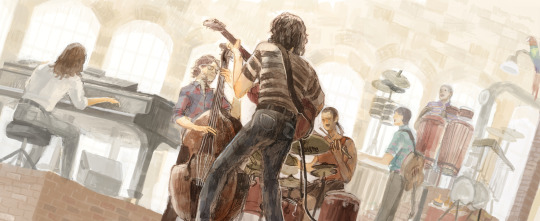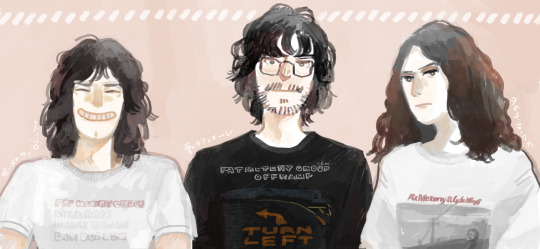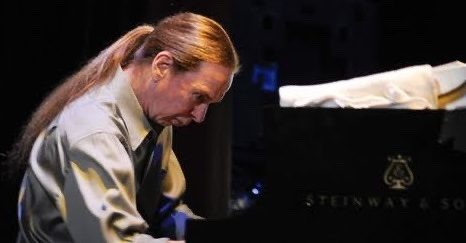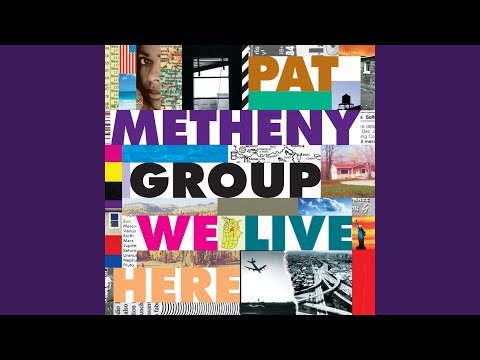#steve rodby
Text
Pat Metheny Group - As It Is

Music Video
youtube
Artist
Pat Metheny Group
Composer
Pat Metheny
Lyle Mays
Produced
Pat Metheny
Lyle Mays
Credit
Pat Metheny – acoustic and electric guitars, guitar synthesizer
Lyle Mays – piano, keyboards
Steve Rodby – double bass, cello
Richard Bona – vocals, percussion, acoustic guitar, fretless bass
Cuong Vu – trumpet, vocals
Antonio Sánchez – drums
Released
February 12 2002
Streaming
youtube
#pat metheny group#pat metheny#lyle mays#steve rodby#richard bona#cuong vu#antonio sánchez#2000s#2002#music#Youtube
7 notes
·
View notes
Text
Round one


Scorpions
Formed in: 1965
Genres: Hard rock, heavy metal
Lineup: Klaus Meine- vocals
Rudolf Schenker- guitar
Matthias Jabs- guitar
Francis Buchholz- bass
Herman Rarebell- drums
Albums from the 80s:
Animal Magnetism (1980)
Blackout (1982)
Love at First Sting (1984)
Savage Amusement (1988)
Propaganda:
Pat Metheney Group
Formed in: 1978
Genres: Jazz, fusion
Lineup: Pat Metheny – acoustic and electric guitars, guitar synthesizer
Lyle Mays – piano, synthesizers, electric organ, autoharp, Synclavier
Steve Rodby – acoustic and electric bass, bass synthesizer
Danny Gottlieb – drums
Albums from the 80s:
Offramp (1982)
Travels (1983)
First Circle (1984)
The Falcon and the Snowman (1985) (soundtrack)
Still Life (Talking) (1987)
Letter from Home (1989)
Propaganda:
#round 1#Scorpions#scorpions band#pat metheny group#klaus meine#rudolf schenker#matthias jabs#francis buchholz#herman rarebell#pat metheny#lyle mays#Steve rodby#Danny gottlieb#The hottest 80s band tourney#The hottest 80s band tournament#tumblr polls#poll
5 notes
·
View notes
Video
youtube
Pat Metheny Group, Imaginary Day Live, 0: Intro, 1998.
Pat Metheny - Guitar, Lyle Mays - Keyboard, Steve Rodby - Bass, Paul Wertico - Drums, Live Concert at Mountain Winery, Saragota, Californien, 1998.
#pat metheny#lyle mays#steve rodby#paul wertico#pat metheny group#jazz music#90s music#musik#imaginary day
6 notes
·
View notes
Text
"Still Life (Talking)": Pat Metheny's Timeless Sonic Masterpiece
Introduction:
Certain albums stand out as true milestones in the history of jazz and instrumental music, creating a lasting impression on the genre and influencing subsequent generations of musicians and fans. “Still Life (Talking),” an album by the Pat Metheny Group, is one such timeless gem. This beautiful work of art, which was released in 1987, displays the virtuosity and ingenuity of…

View On WordPress
#Armando Marçal#Classic Albums#Danny Gottlieb#David Blamires#First Circle#Jazz History#Lyle Mays#Mark Egan#Mark Ledford#Offramp#Pat Metheny#Pat Metheny Group#Paul Wertico#Steve Rodby#Still Life (Talking)
1 note
·
View note
Text

Pat Metheny Group – Still Life (Talking)
Still Life (Talking) is the fifth studio album by the Pat Metheny Group. It was released in 1987 on Geffen Records. It won the Grammy Award for Best Jazz Fusion Performance[4] and was certified gold by the RIAA on July 2, 1992.
Pat Metheny – acoustic and electric guitars, guitar synthesizer
Lyle Mays – piano, keyboards
Steve Rodby – acoustic and electric bass
Paul Wertico – drums
Armando Marçal – percussion, backing vocals
Mark Ledford – vocals
David Blamires – vocals
2 notes
·
View notes
Text
youtube
Pat Metheny -One Quiet Night
Solo Guitar: Pat Metheny
℗ 2003 Metheny Group Productions
Assistant Engineer: E. Scott Lindner
Assistant Engineer: Jay Spears
Producer, Recorded by: Pat Metheny
Additional Engineer: Pete Karam
Mixer: Rob Eaton
Co- Producer: Steve Rodby
Masterer: Ted Jensen
-
*Writer: Keith Jarrett*
1 note
·
View note
Text
Investments Never Realized
By this time, I was into Wes, and I explained to my dad, “I need a guitar that’s more like that first one.” I made a deal with him where if I could earn more money and sell the Mustang, I could get another guitar. Also, they could kind of see that this was happening quickly, and I could play a little bit almost right away. So I got permission again to spend my own money to get something better. After I found somebody to buy the Mustang, my dad and I found an ES-175 for sale. The guy wanted $120, and dad talked him down to $100. And he also had a bass, and he offered to sell us that for $75. My dad said, “We’ll give you 60,” and the guy went for it. That was a ’58 Fender Precision, which I later gave to Jaco Pastorius, who did his whole thing on it, and that was the bass that Mark Egan played all those years. Then Steve Rodby played it when he joined, but it was stolen in Argentina.
-Pat Metheny
I just want to put this steal in perspective. He got a 1960 Gibson ES-175 AND a 1958 Fender Precision Bass for a COMBINED $160. Let me put it to you this way...ONE pickup from that 175 would be about...what?...12 times that combined $160 today.

Currently, there are no 1960 blonde 175′s available. If there were, add a good $1,500-$2,000 to this price. And add that same premium again due to the incredibly, ultra-rare bound headstock...something I legitimately have never seen for sale (we’re talking maybe dozens have been specially made with a bound headstock, on a guitar that was in production since 1948**).


...of course, this return of 23,962.50% was never realized, but it’s still fun to think about. And that’s with a P-Bass without the original case (add an extra $1k).
He mentioned simply giving that P-Bass away to Jaco (god, whomever stole this in Argentina is sitting on a fucking gold mine right now), so he got bubkus on this particular Holy Grail instrument.
As for the ES-175?


Pat Metheny is one of the hardest working musicians I can think of. In the three decades this guitar was in use, it was almost constantly in his hands...as he didn’t even carry a backup. After three decades of abuse, this guitar was literally held together with duct tape and a toothbrush.
I’d say he got his money’s worth in the end.
**This is the only other bound headstock ES-175 I’ve seen played by a famous musician...Bill Frisell’s teacher specially ordered a 175 with an ebony fretboard, bridge, a P-90 instead of the stock PAF humbucker, and a maple neck...making this guitar more like Gibson’s L-5 than a true 175.
I’ve seen maybe a dozen of these bound headstock 175′s online...almost all specially ordered and in the hands of the first or second person the guitar was purchased by. Frisell’s guitar is pretty cool...it was stolen in Boston, and 40 years later, he found it in a Seattle guitar store 12 miles away from his current residence. Crazy circumstance.
0 notes
Photo







Pat Metheny Group - 1
44 notes
·
View notes
Text

"One of the Greatest Musicians," Lyle Mays Dies at 66
Keyboardist Lyle Mays, co-founder, composer and arranger for the Pat Metheny Group who also played with Joni Mitchell and others as a sideman, died Feb. 10, according to a statement on Metheny's webpage.
Mays was 66 and died "after a long battle with a recurring illness," the statement said.
"Lyle was one of the greatest musicians I have ever known," Metheny said. "Across more than 30 years, every moment we shared in music was special. From the first time we played together, we had an immediate bond. His broad intelligence and musical wisdom informed every aspect of who he was in every way. I will miss him with all my heart."

Metheny Group bassist Steve Rodby recalled the "great privilege” of having Mays in his life "as an inspiration and a friend.
"As anyone who knew him and his music will agree, there will only be one Lyle, and we will all continue to appreciate his soulful brilliance in so many ways," he said.
In 1979, Mays, Metheny, Jaco Pastorious, Michael Brecker and Don Alias joined Mitchell's band. On Facebook, Mitchell's team remembered the keyboardist as the "metric backbone of the (Metheny) group's musical signature" and called him "an integral part" of Mitchell's tour that year.
"He and Pat's hauntingly beautiful transition between 'Amelia' and 'Heijra' still stands as one of the highlights of the tour video," they wrote.
2/11/20
#lyle mays#the pat metheny group#pat metheny#jaco pastorius#steve rodby#joni mitchell#michael brecker#don alias
13 notes
·
View notes
Text
To The End Of The World, por Pat Metheny Group
To The End Of The World, por Pat Metheny Group
To The End Of The World es un tema compuesto por los músicos estadounidenses Pat Methneny y Lyle Mays, quienes desde hace más de 40 años bendicen mi vida.
(more…)

View On WordPress
#Argentina#Chubut#Lyle Mays#Pat Metheny Group#Pat Methneny#Patagonia#península de Valdés#Steve Rodby#To the End of the World#We Live Here
0 notes
Text
Track review-- A deeper look at: Lyle Mays “Eberhard” (Self produced, 2021)

Lyle Mays (piano, keyboards, synthesizers), Bob Sheppard (sax and woodwinds), Steve Rodby (acoustic bass), Jimmy Johnson (electric bass), Alex Acuña (drums and percussion), Jimmy Branly (drums and percussion), Wade Culbreath (vibraphone and marimba), Bill Frisell (guitar), Mitchel Forman (Hammond B3 organ, Wurlitzer electric piano), Aubrey Johnson (vocals), Rosana Eckert (vocals), Gary Eckert (vocals), Timothy Loo (cello), Erika Duke-Kirkpatrick (cello), Eric Byers (cello) and Armen Ksajikian (cello)
When pianist, synthesist and composer Lyle Mays passed on February 10, 2020 from a lengthy battle with an undisclosed illness, to say it was shocking to all those who enjoyed both his work with the Pat Metheny Group (1978-2005, with officially undocumented Japanese and European tours during 2009-10) and his small catalog as a bandleader was an understatement. The word genius is overused in the music and entertainment industry but Mays truly was a genius in every sense of the word. Not only was he a fabulous musician and composer, but he was multi-talented. Among his many interests outside music: architecture, he had designed his own Los Angeles house as well as one for his sister in Wisconsin; he was a soccer enthusiast that while he was with the PMG actually taught and coached a local team a distinct Brazilian style of play, he was a computer programmer, and a billiards player who played on the professional circuit. Above all, Mays’ attention to structure, detail and compositional drama was a hallmark of his own work, and his brilliant harmonic mind always contributed effervescent improvisational ideas. While he possessed chops in spades, the keyboardist always used them in a meaningful way. As a synthesist Mays was the most significant musician after Herbie Hancock, Chick Corea and Joe Zawinul as a player in the “jazz” field.
Eberhard, composed in 2009 for the Zeltsman Marimba Festival, is a tribute to one of Mays’ greatest influences: the bassist Eberhard Weber. The 13 minute track, which is being released world wide as a single on CD, LP and streaming formats is in many ways a perfect bookend to Lyle Mays (Warner Bros/Metheny Group Productions, 1986) the titular debut record that, while sounding quite unique from anything in the so called “fusion” field was critically panned at the time. In the decades since, the album has gained a cult following as a bonafide classic. The remainder of Mays’ catalog (including a 1993 quartet concert released 22 years later The Ludwigsburg Concert) has broad reach that in its totality represented restless exploration and traversed multiple trails simultaneously.
After the PMG’s The Way Up however, Mays had reservations about where the music industry was going and retired from the music industry instead working a regular position as a software engineer. He also couldn’t deal with the rigors of touring and after the aforementioned PMG Songbook tour of Europe and Japan during 2009-10, Mays had had enough. Though there were rumblings of Metheny and Mays writing for a new Group record a few years later, ultimately the plans were scrapped and the keyboardist made relatively few live appearances, instead focusing on a few teaching appearances co lead with collaborator and sound designer Bob Rice (most known as a Synclavier operator for Frank Zappa) and a widely viewed TED Talks appearance. Mays had also become an endorsee for synthesizer companies Arturia and Trillian Spectrasonics.
Sometime in 2019 Mays’ health began to worsen and decided he needed to record Eberhard so it is not a traditional posthumous release because he was involved in every aspect of playing, composing, recording, orchestrating and producing. As an associate producer, long time PMG band mate, acoustic bassist on the track and best friend Steve Rodby says in the liners, Eberhard was not to be the last work of Lyle Mays and he had plans for more. After Mays’ death, on the Pat Metheny website, the guitarist posted some words about his long time musical compatriot and indicated that he and Mays had been talking about a wacky idea of which he could not reveal the details, but that it was something related to a sequel of their classic As Falls Wichita, So Falls Wichita Falls (ECM, 1981). Eberhard is significant for being the largest ensemble Mays ever led, at 16 members bringing back Alex Acuna and Bill Frisell from the first album, Steve Rodby on acousic bass (who appeared on 1988’s Street Dreams) and featuring mallet player Wade Culbreath, electric bassist Jimmy Johnson, vocalists Rosanna and Gary Eckhart as well as Mays’ niece the rising Aubrey Johnson. A string quartet, Bob Sheppard on reeds, Mitchel Forman on Hammond B-3 organ and Wurlitzer electric piano, and second drummer Jimmy Branly round out the group besides Mays’ piano and keyboards.
Mays’ connection to Weber’s music goes back further than the 2009 composition, which has roots decades before in 1983. While Mays appeared on the bassist’s wonderful Later That Evening (ECM, 1982) Weber had appeared on Pat Metheny’s Watercolors (ECM, 1977) forming the backbone along with drummer Danny Gottlieb of what could be considered a Pat Metheny Group prototype, and the tracks Mays appeared, are really a prequel to Pat Metheny Group (ECM, 1978). Weber remained a profound influence on the keyboardist’s composing, and when the PMG’s swan song The Way Up (Nonesuch/Metheny Group Productions, 2005) was released, the melancholy bass melody of “Part 2” was a direct reference to Weber.
The piece begins with an marimba ostinato from Culbreath, a two note motif with a touching chord progression. Mays states a few of the melodic ideas with his signature piano reverberating in the atmosphere with trademark subtle layers of keyboards and percussion from Acuna. It’s important to note the striking similarities in style between Mays and Weber keyboardist Rainer Bruninghaus. Mays and Bruninghaus, it must be said conjecturally, seem to have explored parallel paths in their harmonic styles and solo wise. Jimmy Johnson’s fretless bass then takes center stage for a bass melody redolent of Weber, before things really begin to percolate with minimalist motifs that are quite influenced by Indonesian Gamelan music (shades of the title track to Imaginary Day) and Steve Reich. Flutes state a motif taken directly from Weber’s “T. On A White Horse” on The Following Morning (ECM, 1974) and the first bits of wordless vocals appear with the motif, the percussive vocal effects that appear from the far left and right parts of the sound stage are reminiscent of the synth effects Mays used on “Northern Lights”, the first movement of the “Alaskan Suite” from Lyle Mays. There are also musique concrete sonic collages that frame the eerie dream like sequences much like the first two parts of Street Dreams (Warner Bros./Metheny Group Productions, 1988).
Mays takes a solo that builds in intensity and arc before the main musical kernel melodically is revealed behind Acuna’s drums and the wordless vocals from the Eckhart’s and Johnson. During a further development of this section, Mays and Johnson engage in an awe inspiring duo with Johnson’s vocals in unison with his keyboards. It is here and only here, for a couple of bars does Mays signature ocarina like synth lead appear, more as a texture placed in the mix alongside other sounds. Bob Sheppard, ace LA studio player and longtime associate of the keyboardist takes a searing tenor sax solo buoyed by Rodby’s inimitable bass and surging intensity from the rest of the ensemble. An intriguing aspect of Mays’ comping behind Sheppard revolves around a device he loved to use, where rhythmically his lines “pulse” much like the way Stravinsky has rhythmic pulsing in pieces like The Rite Of Spring and The Firebird. Another fine example of this style of comping would be the way Mays comps behind Pat Metheny’s guitar synthesizer solo on “As It Is” from Speaking of Now (Warner Bros. Metheny Group Productions, 2002) though there are numerous other examples of Mays doing this in other tracks throughout his discography. Once things reach the point of no return in terms of build, the piece ends as quietly as it began. The marimba ostinato returns behind the subtle synth underpinning and the piece achieves an utterly satisfying resolution. It is remarkable that in 13 minutes the piece travels as much territory as it does, it feels as if the listener has been on a much longer journey.
Sound:
Recorded, mixed and mastered by Rich Breen, Eberhard was recorded during the latter parts of 2019 up through January 2020. The familiar hand of Steve Rodby served alongside Bob Rice as associate producers and sonically the piece is full and dynamic covering the entire sound stage. Production wise, the album falls between Lyle Mays and Street Dreams. As with those albums, Frisell is a textural voice in the mix as opposed to a lead voice, and he seamlessly blends into the soundscape in a way the listener may not notice. Mays’ piano is at once gleaming but also relatively dark in timbre but is so resonant across the sound stage with reverb. Drums, and bass all sound accurate and have appropriate punch, and new details in the sub mix reveal themselves over time upon multiple listening.
Concluding Thoughts:
In a cultural era where the light music brings is needed more than ever Eberhard is simply a gift. Mays’ entire catalog is worth investigation, but there is something about the piece that places it near the top, it is perhaps barring none, the finest compositional achievement of his entire career. On its own terms it is wondrous, for those who have missed Mays’ contributions to the Metheny Group this will fill a much needed hole, but in terms of the keyboardist/composers’ oeuvre as a leader this quite simply is the piece de resistance and easily fits as the bookend to the self titled opus and a perfect capstone to a remarkable career and life.
Music: 10/10
Sound: 9.5/10
Equipment used for review:
HP Pavilion X360 laptop (for digital promo streaming)
Marantz NR1200 stereo receiver (used as preamp)
Marantz MM 7025 power amplifier with AKM 4000 series dual DAC’s
Focal Chora 826 speakers
Beyerdynamic DT 770 Pro headphones
Audioquest Forest and Golden Gate cables
Canare 4S11 speaker cable
4 notes
·
View notes
Text
From Secret Story (1992)
Pat Metheny, Steve Rodby, Nana Vasconcelos, Armando Marçal, Gil Goldstein, Will Lee, Steve Ferrone, Paul Wertico, Mark Ledford, and The London Symphony Orchestra.
1 note
·
View note
Text
youtube
Pat Metheny Group, Imaginary Day Live, 6: Across The Sky, 1998.
Pat Metheny - Guitar, Lyle Mays - Keyboard, Steve Rodby - Bass, Paul Wertico - Drums, Live Concert at Mountain Winery, Saragota, Californien, 1998.
#pat metheny group#music#jazz music#pat metheny#lyle mays#steve rodby#paul wertico#imaginary day live#imaginay day#across the sky#Youtube
3 notes
·
View notes
Photo

Round About Midnight
素晴らしいアルバムを手に入れた。
ある夜"'Round Midnight"を急に聞きたくなった。我が家のオーディオ母艦である、Pioneer XC-HM86のTREBLEコントロールを一コマ上げてみたら、途端に理想的な音になったので、色々聞いてみたくなったのが間接的な原因。トーンコントロールをブーストするとスピーカーに負担がかかるとも聞くが、自宅ではそもそもボリュームを上げないし、小さなSPをトーンコントロールで満足する音にすることは、個人的には"あり"だと思っている。
話しを戻して。。"'Round Midnight"はJazzのスタンダート曲。その曲が入っているアルバムとして、"Great Lawn/Ross Trout & Steve Rodby"を持っていたが、純粋なJAZZアルバムではない。この際一つ買ってみようと思うものの、余りに有名なこのスタンダード曲をカバーするミュージシャンは非常に多い。さて、どのアルバムにしよう。。
Webで検索してみると、評価が高いものはマイルスのもの。たしかにミュート奏法でのあの曲がよいだろう事は簡単に想像できる。さっそく調べると、同じアルバム名でいくつか種類があったが、「Round About Midnight(MONO)(期間生産限定盤)」というのを買ってみることにした。価格はなんと¥1000。「オリジナルは1956年のものだから、さすがにモノラル録音か」と思いつつも聞いてみると、モノラル録音を疑うほどの素晴らしい音。このアルバムには他に、4曲のボー��ストラックを加えた2001年に再販されたアルバムもあるが、購入したものは2013年にアナログマスター音源からリマスターされたものらしい。
そのリマスターの仕方が良いのでしょうね。このアルバムは¥2500ほどでハイレゾ音源も販売されているが、半額以下の投資で手に入れることができたこのCDは十二分に良い音。あらためて「ハイレゾだからよい音だ」ということではない事を実感したアルバムでした。
2 notes
·
View notes
Text

Pat Metheny Group – Offramp
Offramp is the third studio album by the Pat Metheny Group, recorded in October 1981 and released on ECM May the following year. The performers are Pat Metheny; Lyle Mays, Steve Rodby and Danny Gottlieb in the rhythm section; and percussionist and singer Naná Vasconcelos.
Pat Metheny – electric and acoustic guitar, guitar synthesizer, Synclavier
Lyle Mays – piano, synthesizers, autoharp, electric organ, Synclavier
Steve Rodby – electric and acoustic bass
Danny Gottlieb – drums
Naná Vasconcelos – percussion, voice, berimbau
0 notes
Text
JazzX5#204. Pat Metheny Group: Question and Answer (The Road to You (Live in Marseilles, France, 1991) [Minipodcast] #YoMeQuedoEnCasa / #IStayAtHome
JazzX5#204. Pat Metheny Group: Question and Answer (The Road to You (Live in Marseilles, France, 1991) [Minipodcast] #YoMeQuedoEnCasa / #IStayAtHome
Por Pachi Tapiz.
“Question and Answer”
Pat Metheny Group: The Road to You (Live in Marseilles, France, 1991. Bootleg)
Pat Metheny, Lyle Mays, Steve Rodby, Paul Wertico, Armando Marçal, Pedro Aznar
© Pachi Tapiz, 2020
JazzX5 es un minipodcast de HDO de la Factoría Tomajazz presentado, editado y producido por Pachi Tapiz.
JazzX5 comenzó su andadura el 24 de junio de 2019.
Todas las entregas de JazzX5
View On WordPress
0 notes